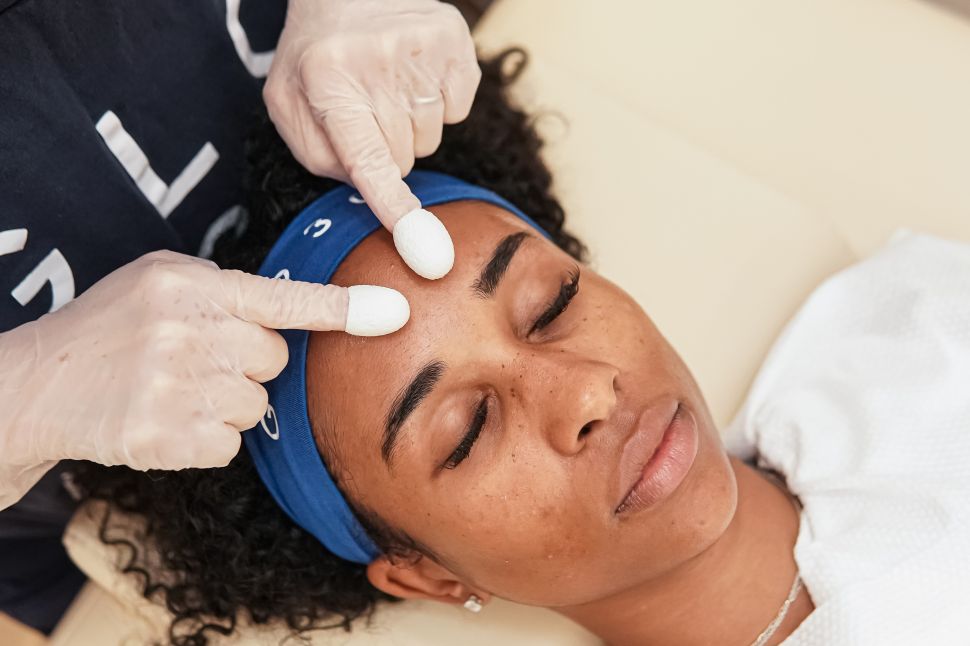As A.I. makes its way into the beauty industry, in-clinic skincare experiences like facials are rapidly shifting from human intuition to data-driven analysis powered by technology. A.I. powered skin analysis tools like VISIA and Alma IQ are making the skincare space increasingly innovative and competitive. Some companies are betting entirely on technology to set them apart from competitors. One of the early adopters is GLO30, a membership-based skincare franchise that offers personalized, science-backed treatments enabled by A.I.
As a technology reporter and facial enthusiast, I visited a GLO30 studio in Columbia, Md.—one of its 12 U.S. locations—earlier this month. The experience began with a cup of cherry blossom tea, a nod to the studio’s seasonal facial theme, followed by an introduction to GLOria, GLO30’s proprietary A.I. skin analyzer.
Displayed on a large screen, GLOria prompted me to input basic information like skin type (mine is a mix of oily and dry) and location (used to factor in local weather and pollutants). After snapping a photo, the program offered an assessment: my skin scored well for undereye circles, dullness and wrinkles but needed improvement in smoothness, shine, tone and pigmentation. The critique was fair—especially the part about hyperpigmentation, which highlighted spots I already knew, including a cherry angioma on my forehead.
Based on this assessment, GLOria recommended the SmartGLO facial, a monthly treatment priced at just under $200, and at-home products like sunscreen and facial wipes.
Founded in 2012 by husband-and-wife team Herman Singh and Arleen Lamba, a former anesthesiologist, GLO30 has amassed over a decade’s worth of customers’ facial scan data—valuable fuel for its A.I. model, developed by Singh, who serves as GLO30’s president. The company promises it will never sell customer data. It also offers traditional skincare services that don’t require customers to submit personal information.
The human touch still matters
GLO30’s A.I. model is constantly improving as it gathers more data. But it’s far from perfect. At the Columbia location, natural light from a nearby floor-length window can affect scan accuracy. “We’d love a little more accuracy on that picture,” Lamba told Observer. “It’s a great picture, but sometimes it can be a little finicky based on where we’re scanning, or the temp, or the type of sun we’re getting.”
To address such limitations, GLO30 is looking to introduce an app that allows customers to their skincare habits at home, adding even comprehensive and personalized data to refine the A.I. learning.
Nevertheless, the human touch still matters. At the studio, Karla Miller, an esthetician who joined GLO30 last fall, performed my treatment, which included a snail mucin mask for hydration, an ultrasonic skin scrubber to clear clogged pores and a high-frequency wand to target acne-causing bacteria.
Miller overrode GLOria’s suggestion that I use the brand’s skin-brightening pads, explaining that my skin was too sensitive and needed barrier repair instead. It’s a reminder that, like A.I. application in all industry, keeping a human in the loop remains essential.
Is A.I. skincare a marketing gimmick?
My experience was incredible—I had no redness (a common post-facial issue for me), and my skin looked glowing for days afterward. But how much of that was due to the A.I. itself, versus Miller’s expertise and the high-quality products she used?
“A.I. is incredibly powerful but still in the early innings,” Mariah White, a Seattle-based aesthetic nurse practitioner who runs an at-home med spa service company, told Observer. She sees A.I. for skincare as more of a marketing hook than a true decision-maker. “A good A.I. tool can educate and entertain, but is a tool rather than a replacement for a medical professional and their client,” she said.
Lindsay Malachowski, founder of TREAT Medspa who formerly led operations at Skinney Medspa in New York and Florida, said GLO30’s A.I. model excels at identifying surface-level factors like tone, texture, and tightness. However, it “may not be as effective at analyzing UV damage, redness or porphyrin analysis (bacteria) underneath the skin” compared to competitors like VISIA and Alma IQ, she told Observer.
Another limitation is that A.I.-powered skin analysis tools are often designed to promote a company’s own products. The Alma IQ system, for example, “may be more linked to recommend Alma-based treatments and not give a full range of treatment recommendations that would be available to clients,” Malachowski noted. The same applies to GLO30, which relies exclusively on its own branded products.
At this stage, A.I.-enabled facials are perhaps better described as A.I.-supported—where datasets and analysis serve as one component in an esthetician’s broader toolkit. Unlike other fields where A.I. aims to save time—like customer service—facials remain a deeply personal, hour-long ritual. No competent, trustworthy esthetician is trying to cut corners. Instead, the technology helps deepen one’s understanding of their skin, allows for meaningful comparisons over time, and may empower clients to make more informed treatment decisions.

